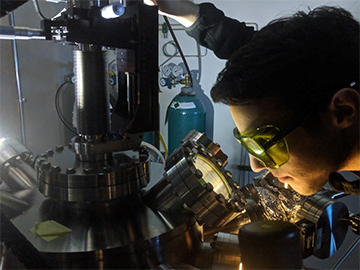DOE, SESAPS Honors for Physics Students
They study the trails neutrinos leave behind, and the intricacies of ultra-thin materials, and they have been duly rewarded for their efforts.
Graduate Students Gray Yarbrough and Andrew Mogan have won awards from the Department of Energy Office of Science Graduate Student Research (SCGSR) program, while Undergraduate Physics Major Peyton Nanney was recognized for the best undergraduate oral presentation at the Southeastern Section of the American Physical Society Meeting (SESAPS).


Graduate students Andrew Mogan (left) and Gray Yarbrough have won support from the DOE Office of Science Graduate Student Research program to work on the MicroBooNE experiment at Fermilab.

Undergraduate Physics Major Peyton Nanney was recognized for his outstanding oral research presentation at the SESAPS meeting in November.
Both Yarbrough and Mogan work with Assistant Professor Sowjanya Gollapinni at MicroBooNE, a 170-ton Liquid Argon Time Projection Chamber (LArTPC) neutrino experiment at Fermilab. The project is designed to both probe neutrino physics phenomena and further develop the LArTPC detector technology. In MicroBooNE, the interaction of neutrinos with liquid argon produces various charged particles that strip off electrons from the argon atoms, leaving a trail as they pass through the detector. Scientists at MicroBooNE study these trails left by particles to learn more about the neutrinos themselves which ultimately leads to a better understanding of the Universe we live in.
The SCGSR program provides supplemental awards to outstanding U.S. graduate students to pursue part of their graduate thesis research at a DOE laboratory in areas that address scientific challenges central to the Office of Science mission. Multiple fields are represented, including physics, chemistry, engineering, math, and computational sciences. As part of this award, Yarbrough and Mogan will spend a year at Fermilab to work on MicroBooNE, beginning in January 2018.
This funding cycle awarded 52 students from 37 U.S. universities. Five of those students were from the University of Tennessee. With Yarbrough and Mogan’s awards, Gollapinni is the advisor to both UT Physics recipients, and they are the first students to win SCGSR support to work on MicroBooNE at Fermilab.
Mogan said “the SCGSR fellowship is going to be a huge help for both my research and my future career. It will allow me to work on-site at Fermilab, surrounded by brilliant people and plentiful resources, all while covering my bills and eliminating financial stress.”
Yarbrough, who won a Fermilab Neutrino Physics Center (NPC) fellowship in summer 2017, will work under the mentorship of Zarko Pavovic, whom he called “an expert in beam physics.” He said the “the analysis is expected to improve MicroBooNE's beam flux prediction and reduce systematic uncertainties, and the work will also be a valuable part of my thesis.”
It’s not only the graduate students making contributions to the department’s research. Senior Peyton Nanney was recognized for his outstanding presentation on the “Synthesis of Ruddlesden-Popper Strontium Iridate Epitaxial Thin Films” at the APS Southeastern Section meeting in mid-November.
Nanney, who as a freshman won a Dorothy and Rufus Ritchie Scholarship, also serves as president of UT’s Society of Physics Students. He first began working with Assistant Professor Jian Liu’s group through the department’s Summer Research Fellowship program in 2016. His project focuses on optimizing conditions to synthesize thin films made from strontium and iridium within the Ruddlesden-Popper family. Thin films range in thickness from a single layer of atoms to just a few micrometers. The Ruddlesden-Popper structures—named for the scientists who first synthesized them—have interesting properties such as superconductivity and ferroelectricity. Nanney’s work involves how best to grow these films via pulsed laser deposition. The group investigated the factors influencing the thermodynamic interactions of this process and the resulting material phases—culminating in a map that allows for the most stable phases in these materials, and consequently for the best analysis of their magnetic properties. Nanney has a key role in this research.
“He is the leading person on this project,” Liu said. “His main duty is to synthesize the samples using the pulsed laser deposition in my lab. My graduate student Junyi Yang helps him with characterizing the sample properties.”
The awards continue a successful year of honors for physics students. Along with Yarbrough’s afore-mentioned Fermilab fellowship, Ryan Rawl (Assistant Professor Haidong Zhou’s student) is currently working on a DOE SCGSR award, and the spring Chancellor’s Honors recognized 10 physics students, both graduate and undergraduate, for extraordinary academic achievement, extraordinary professional promise, undergraduate researcher of the year, and the Torchbearer award.